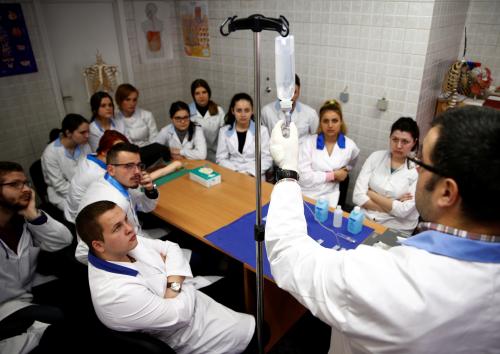Following protests at colleges across the United States during the 2015-16 academic year, many student organizations have issued demands of administrators to increase the representation of minorities and women among faculty and staff. For example, at my institution, the University of Missouri-Columbia, The Legion of Black Collegians has demanded an increase in the percentage of black faculty and staff to 10 percent by 2017-18. Similarly-spirited demands have been made by groups at many universities, including “Who’s Teaching Us?” at Stanford University, “Liberate MSU” at Michigan State University, and “The Irate 8” at the University of Cincinnati, among others.
In an effort to improve the informational foundation for contemporary policy discussions about faculty diversity, Diyi Li and I collected and analyzed data on over 4,000 tenure-track faculty from 40 selective public institutions during the 2015-16 academic year. Our sample of universities was selected based on U.S. News & World Report rankings. We collected data from faculty rosters posted online with a focus on six academic departments: biology, chemistry, economics, educational leadership/policy, English, and sociology. We group the first three departments as STEM fields and the latter three as non-STEM fields. The information we collected about individual faculty includes basic demographics, qualifications and rank, research productivity, and salaries (see our academic article for details about the data).
Our study, which was recently published in Educational Researcher, has two broad objectives. The first is to provide updated evidence on faculty diversity at selective public universities. We document diversity differences between STEM and non-STEM fields and between junior and senior faculty. Surprisingly, the most recent previous study that we could find documenting faculty diversity in both STEM and non-STEM fields uses data from before the turn of the century. The second objective of our research is to document and decompose faculty wage gaps by race/ethnicity and gender.
I direct interested readers to our full paper for information on all of our findings, though I write this post to bring attention to one finding of particular policy importance. Namely, in the fields we study, the underrepresentation of disadvantaged minority and female professors among faculty overall is driven predominantly by a lack of diversity in STEM fields. Non-STEM fields are much more diverse. For example, black faculty account for just 0.7-2.9 percent of faculty in biology, chemistry, and economics; but 8.8-15.1 percent of faculty in educational leadership/policy, English, and sociology. Similarly, women account for just 18.1-31.1 percent of faculty in STEM fields, but 47.1-53.2 percent of faculty in non-STEM fields. Diversity conditions by field are illustrated in Figure 1.
These numbers highlight a severe imbalance in faculty diversity across fields. Why does this matter? To answer this question, it is useful to specify the purposes of diversifying the faculty, and the mechanisms by which improved diversity will achieve these purposes. Although there are many motivations to diversify the faculty workforce, one that seems of first-order importance given the educational mission of universities is to improve outcomes for disadvantaged-minority and female students. A likely mechanism is role model effects. Large gaps in college outcomes between students who differ by race/ethnicity have been documented in research along many dimensions, including STEM attainment; and although women outperform men in college in many respects, they remain substantially underrepresented in STEM fields.
Taking this purpose and primary mechanism as a point of departure, the concern raised by the disparate diversity conditions between STEM and non-STEM fields is that they may serve to perpetuate an already-existing field imbalance in the workforce, both in academia (per our paper) and the broader labor market. That is, if disadvantaged-minority and female students are drawn to fields with more professors who share their characteristics, and such professors are disproportionately in non-STEM fields, the current diversity structure in higher education may serve to reinforce STEM/non-STEM diversity gaps.
Moreover, broad-brush efforts to improve faculty diversity overall may worsen the field imbalance. For example, university administrators could respond to pressure to increase the overall percentage of disadvantaged-minority and female faculty by adding diverse faculty to non-STEM fields, which are already more diverse. Reasons to worry that administrators might follow this hiring strategy include: (a) there are more candidates from traditionally underrepresented groups with Ph.D.s in these fields, and (b) additional faculty hiring lines are often less expensive in these fields owing to lower salaries and overhead costs.
More than anything else, the aim of this post is to call attention to the stark diversity imbalance in higher education between faculty in STEM and non-STEM fields, which we show using very recent data. STEM graduates have higher earnings, and to the extent that the faculty-diversity imbalance nudges students from diverse backgrounds away from STEM fields, it has the potential to exacerbate earnings inequality. Despite recognition of this issue by many in the research community (e.g., see the California Alliance), we are not aware of evidence that faculty diversity in STEM fields is being given explicit attention in administrative efforts to improve diversity on campuses across the U.S. Moreover, our review of demands from student groups at numerous universities, posted online here, provides little indication that STEM-specific issues are being given independent consideration by these groups either.
Earnings differences between individuals with STEM and non-STEM degrees, combined with the disparate diversity conditions between STEM and non-STEM fields among faculty, point toward policies that specifically promote faculty diversity in STEM fields as worthy of attention if the end goal is to improve outcomes for disadvantaged-minority and female students.
The Brookings Institution is committed to quality, independence, and impact.
We are supported by a diverse array of funders. In line with our values and policies, each Brookings publication represents the sole views of its author(s).








